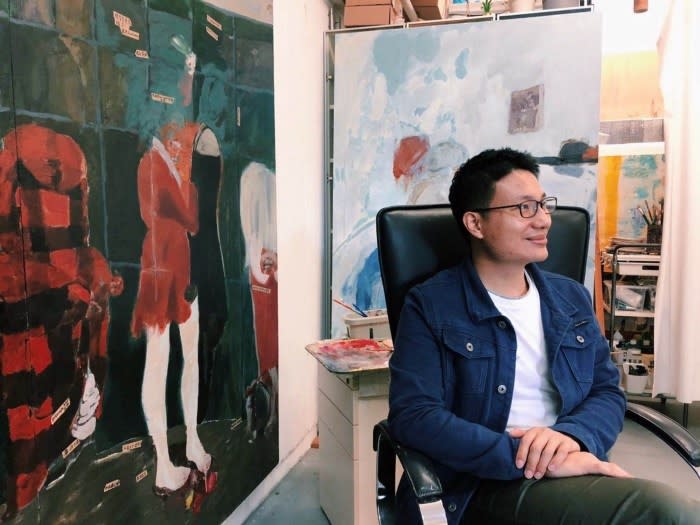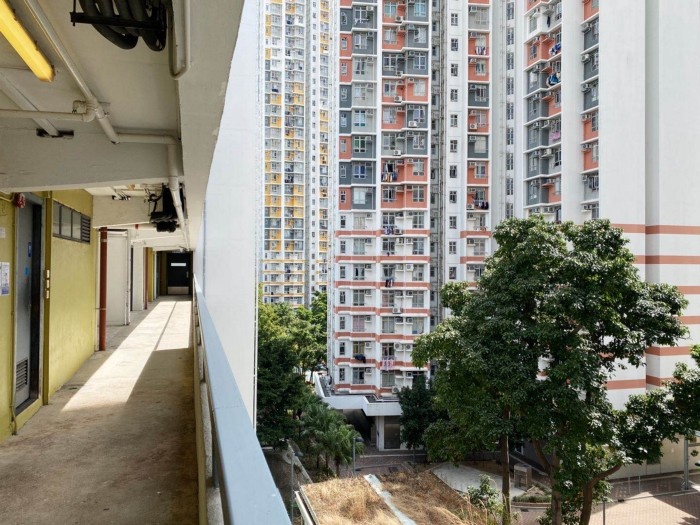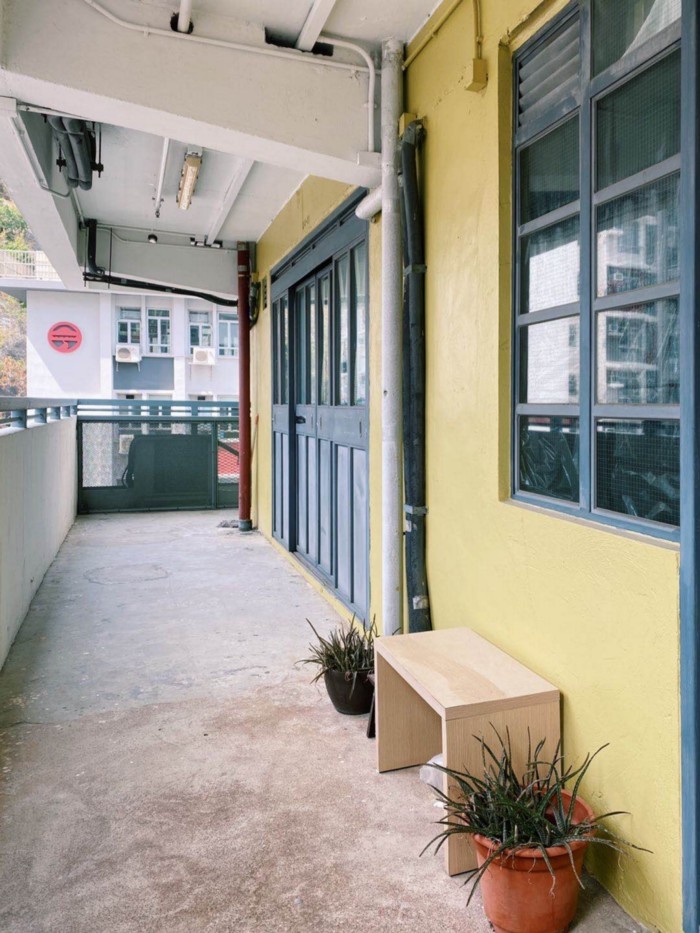
For the first week, we are pleased to invite Hong Kong Artist Halley Cheng to join our discussion about his thoughts and changes towards creating artwork under the recent phenomenon in Hong Kong.
Dr. Henrietta Tsui-Leung: Tsui-Leung
Halley Cheng: Cheng
Tsui-Leung: How are you doing lately ?
Cheng: The most frequently asked question from friends I meet lately is “Are you able to create recently?” Because there have been a lot of frustrations at the moment, artists in Hong Kong have put a lot of energy back into this society. Creation requires energy.
When I arrive in the studio, I feel very split. In fact, the most difficult time for me to create was last June (2019). At that time, I was in Norway for an artist residency when it (social movement) happened, and I was watching the news all day. But when I returned to Hong Kong, I felt less torn, probably because things were closer. Now, I am accustomed to separate my identity. I am an artist when I create and I am a teacher when I teach.
Tsui-Leung: When we first collaborated, we discovered your watercolor paintings. I saw your work at your Fo Tan Studio and contacted you. Later, when we got to know each other better, we also discovered your wooden panel paintings. This time we’re not seeing either series. Can you tell me why this work is neither watercolour nor panel painting?
Cheng: I actually use different methods to create, each of them represent a different approach. Of course, I worked with panel painting at the beginning because Chinese painting was my first entry point in art.
If you pay attention to my panel paintings, you will see that they are mainly lines and don’t have much colour. My first show with you, the first one was watercolour, which mainly used colour blocks and no lines. Finally, when it comes to acrylic painting or oil painting, there are both, lines and colours, as well as texture.
Painting is a medium that takes time for me. In fact, you can see there are a few paintings in my studio. Actually, I’m not only painting one painting at a time, I’m painting several paintings at the same time. Sometimes, some paintings need to be put down and worked on afterwards. So, you will see that I have a lot of stickers on the paintings; these represent some of my ideas at different stages.
I will continue to change; these paintings are constantly evolving. When a painting is completed, it is not necessarily what I think is the best state. Sometimes the best state may occur in the middle of my process and it may not be perfect at the end, but you feel it is complete.

Image: Artist Halley Cheng's Studio (image courtesy of Ora-Ora and the artist)
Tsui-Leung: This idea is very interesting. I think my advantage as a gallery owner is that I can visit you or call you to let me take a look at your work. This allows me to see the development. Most people don’t get a chance to see what you call the best stages. Perhaps there are students watching us, can you explain what you mean by that?
Cheng: It is inevitable. Painting is a stage and you are looking for something. It is very likely that you will find some of the best things in the middle, but these things may not be able to stay in the end. It’s also similar to the relationship between people.
Tsui-Leung: In fact, a SIM card was attached in this location.
Cheng: This work has several SIM cards. In fact, this work is depicting a group of Filipino helpers. During this period, I often painted portraits and figures. This is because I am not good at interacting with people. However, I have to face and deal people more recently due to the stage of life I’m in.
This made me wonder more about the situations of people, or the situations of human beings. I think domestic helpers are in a very strange environment in Hong Kong. You can hardly imagine how people are on call 24 hours or how a job can require being on call 24 hours a day. I use SIM cards as a form of symbolism for this, due to my parents’ occupations they are often in contact with Filipino and Indonesia helpers, so I understand a lot about their mentality.
Recently, I’ve been collecting a lot of SIM cards that the helpers don’t want anymore. I think SIM cards can symbolize them, because they don’t have a proof of address in Hong Kong, so they can’t sign up for mobile service like other Hong Kong people can. If we sign up for mobile services, our phone number lasts for a long time. My personal phone number I’ve used since high school until now. However, for the helpers, this is a very unstable thing.
They don’t have a fixed number or a fixed SIM card, just like they don’t have roots here. These phone cards have their personal information and contain the phone numbers of different people,I have been painting this for about two months.
Tsui-Leung: So, you said sometimes you come to the studio and feel that the painting is complete for today, so you stop. After a period of time, you take it out again to continue. Since your viewpoint changes during this time, maybe that’s why your characters don’t have heads?
Cheng: Maybe, yes.
Tsui-Leung: I know that you have been painting since you were a child. Creation is part of your life. When you were a kid, your father secretly took your paintings to enter competitions and did not give you much pressure. Until now, you still maintain this same state of life.
Cheng: When I was in college, I was in a state where I was most capable of completing that type of panel painting. Those works were most able to express my thoughts on Chinese art. I think the central idea of Chinese art is to be able to settle down and become one with one’s pursuit. However, I think it’s difficult to settle down in this present state.
Therefore, it requires practice to create. This can be expressed in the works too. You also asked me why the work is piece by piece and looks divided. That’s because everyone is very busy now, no matter in society or in the movement. You may need a lot of time to regulate your mood in order to create each time you return to the studio. This can make the work look like it’s divided, which will affect the feelings brought by the entire painting.
Tsui-Leung: I think this work is interesting because we don’t know when it will be complete.
Cheng: Yeah. I don’t know either.
Tsui-Leung: You already nailed it securely on the wall, but it’s possible it will be different when we see it in the exhibition.
Cheng: Right. I’ve felt fortunate since my birth until the middle of last year. I’ve felt that society was relatively reasonable and stable. In this social state, my own creative process is more diversified and I like to practice my ideas. I experiment more with different media and materials.
However, in such a chaotic situation now, you want to hold on tight to something. Especially art, similar to a belief.
When the world is constantly changing like a turbulent ocean, you hope to grab onto a wooden plank. It will push you to think: In your artistic process, is there anything you can rely on throughout your life? To me, that thing is painting.
So, I think it is the time to use life to verify art and painting. Whether regardless of the constant changes in the external world or how hard the days are, is it still possible to rely on such things?
I think painting as art or a bigger function in society nowadays is being the way to the unknown. Now, many things in this world are already known. It is difficult for you to find something, to take risks, because there are so many things already being revealed. Art is the only thing that leads to the unknown.
I feel that sometimes painting may not be able to fully answer these questions. Instead, when you try to work in other mediums, it allows you to see more clearly the nature of those problems. For this reason, I try different methods to ask questions that a painter won’t question.

Image: Artist Halley Cheng's Studio (image courtesy of Ora-Ora and the artist)
Tsui-Leung: You also teach painting in different places now. Due to the current situation, you have to teach online by using different technologies.
Cheng: Yes, if you are working as a teacher, recently you have to change studio practice to online teaching. At the beginning, everyone was frustrated, because it is difficult for everyone to imagine how to move studio practice to an online platform.
Yeah, I’m doing lectures for the time being. Although I teach studio courses, there are also a lot of lectures because that part is important too. When we think about art or art education, we try our best to bring people closer to an art experience. Like Mark Rothko’s paintings, he doesn’t want his work to be a representation of an experience. He wants his own works to an experience itself. So he has a very strict rule on how to install his work, for example, the height between the painting and the ground, the viewing distance. He wants to bring an experience to the audience instead of just a painting.
Tsui-Leung: What would you do if you cannot paint anymore?
Cheng: I think I would cook.
Tsui-Leung: You know how to cook?
Cheng: Probably dessert. Actually, I don’t know how to cook, but if I can’t draw, I may learn cooking. I believe cooking has similarities to drawing or I should say it’s similar to the way I draw. For example, the portion must be accurate. It’s very precise. Too much salt and it will be too salty. Too little sugar and it would be too light. I think I have the sense of how to handle the portion and of course, the packaging of food and its appearance is important too.
Tsui-Leung: What’s your attitude towards art now?
Cheng: Actually, I don’t think too much about the dialogue between the canvas and the painting. On the contrary, you mentioned earlier that there are many exhibitions or works that intentionally allow the audience to be situated in an experience or present the work as a happening, or as a photo moment. They tend to create the works for that purpose, to be insta-worthy.
I think some people need to change the way they think about art. Many people ask me, what should be the first thing an audience should look at when they encounter a work? Or when they look at a work, many people try to figure out what the artist was thinking. I think the first thing is actually to feel. That is the most precious thing about art.
Many people, or those in our modern society, lose the skill to feel. You don’t have to fully understand the work, but it will bring you emotions through its visual impact if it’s strong enough. In fact, it doesn’t need to have a reason. Yet, it seems that we have lost this sense of security. We feel uneasy when we cannot fully understand what the artist is trying to portray. I think this is strange that there is such anxiety.
Because sometimes when you talk about these experiences, what should be clear is that it’s often added afterwards. When a painting is moved to an exhibition venue from an artist’s studio, many things are designed and exaggerated in order to allow the audience to gain that experience. Yet, those experiences may be far from what the artist’s experience was in his or her studio. It may have been the artist’s original intention.
About Ora-Ora Live
Each week, Ora-Ora’s founder Dr. Henrietta Tsui-Leung will speak with various members of the art community — including artists, curators, academics and other professionals working in the cultural sector — to address topics of interest related but not limited to Hong Kong’s art and cultural scene. Arranged in fifteen to thirty-minute segments, the series aims to be an outlet for creativity and a means to connect with peers who share similar interests. The episodes will also available live on Ora-Ora’s Instagram (@galerieoraora), Facebook (Galerie Ora-Ora) and later on Ora-Ora’s YouTube channel.
